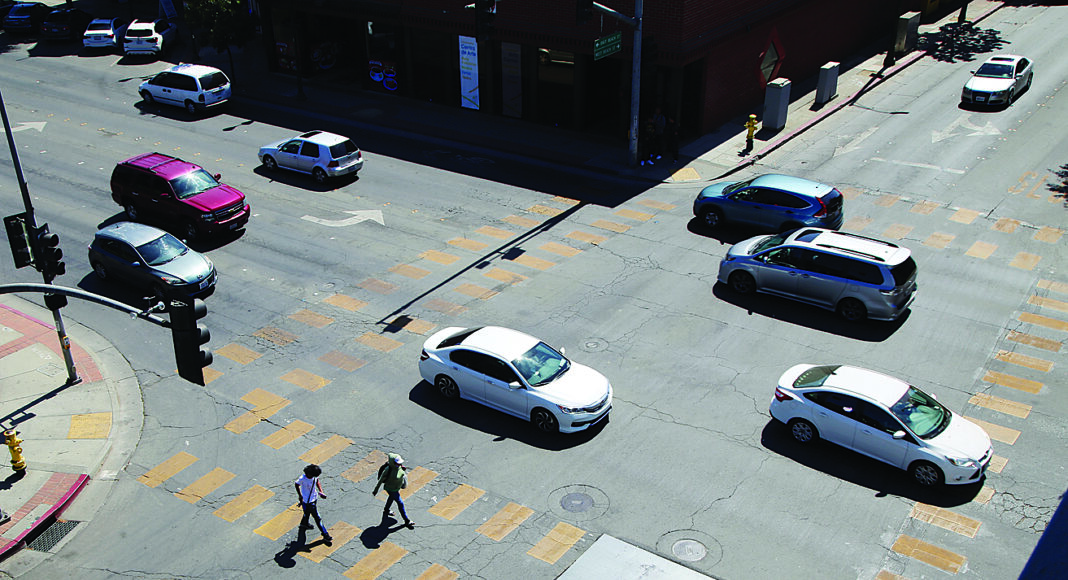The California Department of Transportation (Caltrans) and the City of Watsonville are on the cusp of beginning a 10-year endeavor that will completely reshape the city’s major arterial road.
Caltrans has committed to a $25 million renovation of its roughly seven-mile thoroughfare of Highway 152 that starts at the Highway 1 Main Street exit, flows through Watsonville’s downtown corridor and continues to the Holohan Road-East Lake Avenue intersection.
The project seeks to improve pedestrian and bicycle accessibility and safety for the Santa Cruz County city that between 2013-2019 has consistently ranked among the fifth highest in the number of pedestrian collisions for cities with a population of 50,001 to 100,000—it topped the California Office of Traffic Safety Crash Rankings twice in that time.
The majority of the alterations to the thoroughfare will come in downtown Watsonville, and the biggest change is a so-called “road diet” that will remove at least one lane on Main Street from Freedom Boulevard to East Beach Street.
The Watsonville City Council heard the news during a study session of its Tuesday meeting.
For those following along with the city’s recent long-range planning, various aspects of the project will be familiar. According to Watsonville Principal Engineer Murray Fontes, Caltrans is basing its renovations on concepts included in four plans developed by the city over the past five years: the Downtown Complete Streets Plan, Vision Zero, the 2030 Climate Action & Adaptation Plan and the Downtown Watsonville Specific Plan.
Those documents addressed various issues relating to the city’s future, and they all have a common theme: Changing downtown Watsonville from a car-centric expressway to a pedestrian-friendly destination where a person can live, shop, play and eat without having to hop in a car.
Fontes acknowledged that the plan, especially the reduction of lanes on Main Street, will be a tough sell for some people.
“Implementing [the road diet] will require changes in our transportation lifestyle. They will take time to implement and see the results,” Fontes said. “During the process, some may question our choice. But if we see it through, the results will be transformative as our downtown community will become the safe vibrant area that we are seeking.”
The city council took no action on the item on Tuesday, but it will be asked to vote on a resolution supporting the project at its Sept. 13 meeting. If the city council approves that resolution, it will signal to the state that the city is in favor of investigating the project.
Caltrans will have a litany of tasks it must accomplish before it can break ground. This includes a yearlong public outreach period, the preparation of environmental documents and the creation of detailed designs. Fontes says all of that could take some 10 years to complete.
“Ten years seems like a lifetime,” said Councilmember Eduardo Montesino.
To which Fontes responded: “[Caltrans doesn’t] want to oversell. If it goes faster, it goes faster. But they recognize that transformative projects may need to work at their own schedule … But I think if we said ‘hurry up,’ I think they’d try to accommodate us.”
Along with the road diet, the planning documents the city has completed also call for separated bike lanes, parklets and widened sidewalks, and for changing the traffic patterns on Beach Street and Lake Avenue from one way to two-way roads.
Fontes said the city is currently conducting a traffic study as a final piece for the Downtown Watsonville Specific Plan to measure what impact the road diet and other changes will have to other streets. In addition, Caltrans is expected to conduct its own traffic study and environmental impact reports before moving forward with the changes.
Many of the councilmembers echoed Fontes in saying that it could be difficult to convince residents that these changes would ultimately benefit the community. Councilmember Jimmy Dutra asked questions about the possibility of a group coming forward with a ballot measure to halt the project, and Mayor Ari Parker said that she worried many Watsonville residents are “very concerned of change.”
Councilmembers Lowell Hurst and Vanessa Quiroz-Carter both said the proposed changes would be an exciting way for Watsonville to step into the future and reactivate what was once a thriving downtown area.
“I think it’s very bold of Caltrans and our staff to propose these changes knowing that change is hard and that it’s difficult to project the future as well,” Hurst said. “Yeah, there will be some naysayers on this in lots of ways, but there will also be lots of voices that have not spoken yet.”













